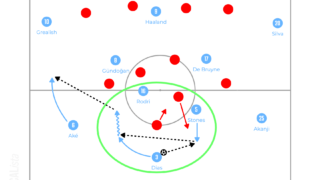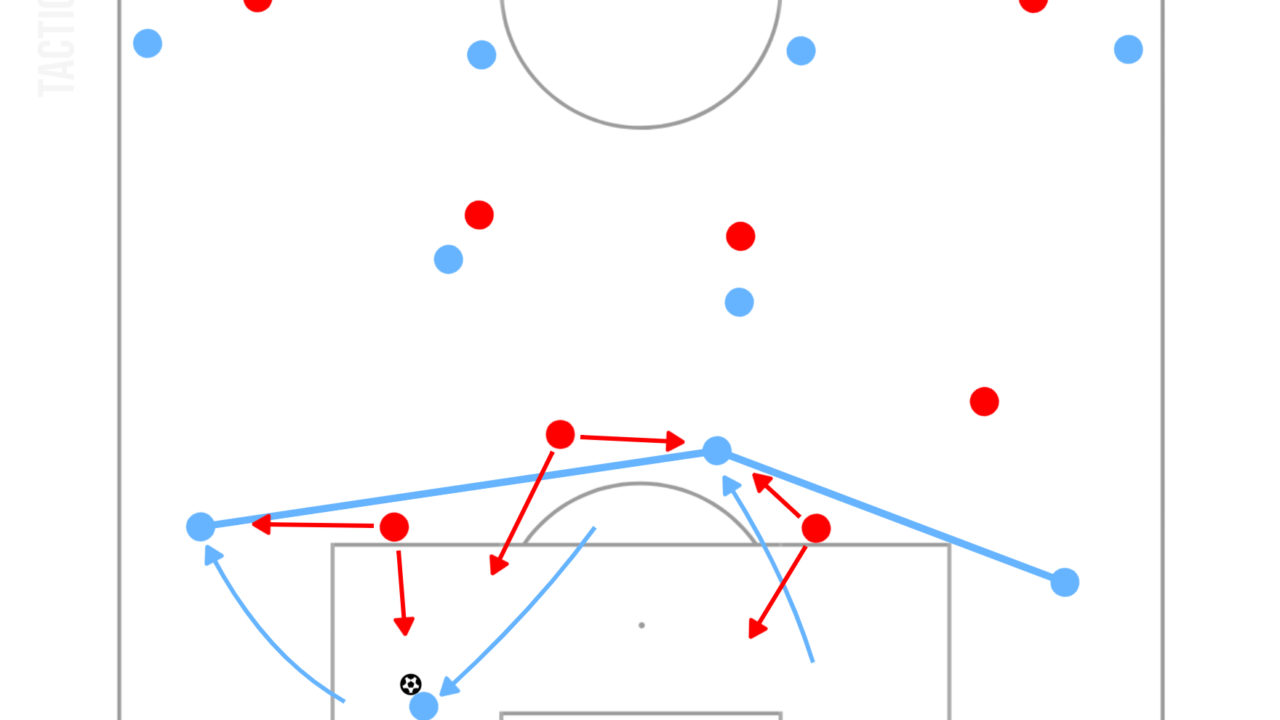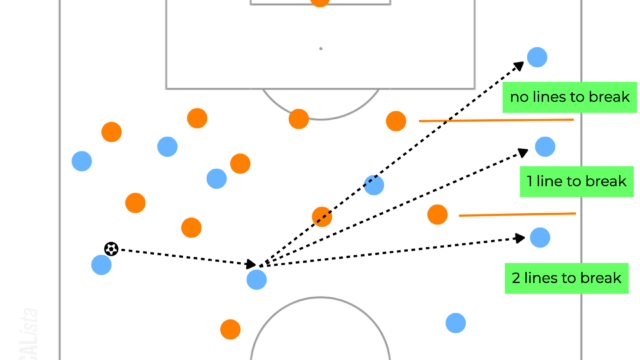Introduction
These days, many teams often play with a back three in possession. At the end of 22-23 season, even Jürgen Klopp’s Liverpool finally decided to play with a back three in possession by moving the right fullback Trent Alexander-Arnold next to Fabinho. Usually, most teams who try to implement the style of positional play prefer to form a 3-2-5 to create some advantages. Then, what are the advantages of playing with a back three in possession? In this article, the reason why a back three is better than a back four in possession is going to be analysed. I hope you enjoy this article.
Flexibility with Goalkeeper
The first advantage is that it is possible to be flexible with a goalkeeper when playing out from the back. When the goalkeeper possesses the ball in front of the goal, in both a back three and four, centre backs drop next to the goalkeeper to keep the depth and make the pitch big to keep away from the opposition pressure or draw it out. If it is a back four, each centre back drops next to each side of the goalkeeper and the shape is symmetric. On the other hand, in the back three, the shape can be asymmetric depending on where the middle centre back is positioned.
When the middle centre back drops to one of the sides next to the goalkeeper, the side in which the middle centre back is positioned is overloaded. Most teams who defend more zonally tend to keep the shape symmetric, so it is possible to create an overload in the side against them.

The side which the middle centre back drop into might depend on the preferred foot, but if the middle centre back can play with both feet comfortably, the power of this flexibility can be maximised. If the overloaded side is constantly swapped, it becomes more difficult for the opposition players to deal with the difference.
However, this advantage might be nullified by man-oriented pressing. In case the opposition team matches their system, to confuse the opposition markers more, it is a great way to drop or step into the other line. The best example of this tactics with a back three is the finalist of UEFA Champions League 22-23 Inter Milan.

The pivot drops into the back line and is positioned next to the goalkeeper in the other side of the middle centre back. If there is only this pattern, it might be easy for the opposition team to adapt it. However, what they were superior is that not only the pivot dropping back but also the middle centre back often steps up into the midfield.

As soon as this rotation is performed, the opposition players need to decide who to mark immediately and if they delay making a decision, the player on the ball can get a time to play a better pass or carry the ball forwards. This rotation at the back including the centre backs cannot be played in a back four because both sides next to the goalkeeper are already occupied, so there is no room for the defensive midfielders to drop into.
Of course, this requires the ability of the middle centre back to play as a defensive midfielder. Thus, overall, to maximise the advantages of playing out from the back with a back three, the middle centre back will be key.
The Difference between Fullbacks and Wide Centre Backs
Another reason will be explained by the reality of how difficult it is to play away from the opposition pressure with a back four. Especially, the fullbacks are often targeted for the opposition team to apply pressure and mark the players around the ball tightly. This is because the passing lanes from fullbacks are limited. Fullbacks by a touchline can only play towards inside and importantly the pass to wingers is vertical and difficult for them to turn around and face forwards. Therefore, fullbacks and wingers are required to possess higher levels of techniques to escape from the opposition pressure in limited space.

On the other hand, wide centre backs in a back three can have an angle to play outside towards wingers. This additional passing lane can help wide centre backs to have more options to play and wingers can also easily receive the ball by their back foot to face forwards.

Additionally, as wide centre backs can possess the ball more inside than fullbacks, the opposition team cannot shuffle across as much as when fullbacks have the ball. This means that the opposition fullbacks cannot close the wingers down when the wide centre backs have the ball. This is another factor why the wingers can face forwards easier when the wide centre backs play to them.
Therefore, having wide centre backs instead of fullbacks makes it easier to keep the possession away from the opposition pressure.
Ambiguity in Wide Areas
The last reason is that systems with a back three can easily change the balance of the shape depending on the positions of wingbacks. If they are positioned higher off the pitch, it is possible to pin the opposition back line and keep dominating in possession. On the other hand, if the wingback drops deeper, it is possible to draw the opposition pressure out and exploit the space in behind quickly. This is because there are only wingbacks in wide areas, so they can and need to play as both fullbacks and wingers. Additionally, the positions of wingbacks can also influence on the role of attacking midfielders.
When the wingbacks step higher to pin the opposition back line, there is space behind the wingbacks. Therefore, the attacking midfielders can drop into the space to receive the ball behind the opposition midfield line. This movement is often performed by İlkay Gündoğan or Kevin De Bruyne when their wingers pin the opposition defenders.


As soon as breaking the opposition midfield line, the opposition team need to drop back or take a risk by getting the ball side defensive midfielder to track the movement and leave the space in the middle. Therefore, this movement often forces the opposition team to drop into a deep defensive block, making it possible for the attacking team to play football in the opposition half like Man City.
On the other hand, when the wingbacks drop deeper to drag the opposition fullbacks out, the task for the attacking midfielders becomes to use the space in behind. This is a trademark of Inter Milan or Antonio Conte.

This requires the wingbacks to flick the ball by their front foot, so it becomes easier when a right-footed player plays as a left wingback. However, this pattern can be performed by using the defensive midfielder as the third man in the space vacated by the run of the attacking midfielder. Therefore, this rotation can be useful for not only exploiting the space in behind but also using the space in the middle.
In short, the different movements between the attacking midfielders and wingbacks are essential to be flexible in the ways of attacking.
Conclusion
Back three systems are extremely flexible in attacking compared with back four systems. The odd number of defenders at the back can create asymmetrical shapes at the back and the combination between the wingbacks and attacking midfielders is also important. I hope you enjoyed this article. Thank you for reading.



